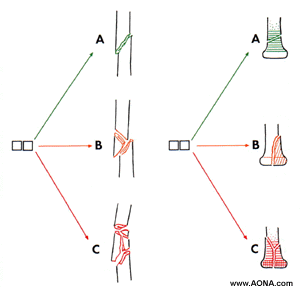
The fracture types A, B and C represent the three possible answers to the first question: "Which type of fracture?" ...

Fig. 3: The fracture types of the diaphyseal and of most of the proximal and distal segments of long bones.
Fracture Types of the Diaphyseal Segment («...» see Glossary)
They are either «simple» (type A) or «multif ragmentary». Multifragmentary fractures are either «wedge fractures» (type B) or «complex» fractures (type C).
Fracture Types of the Proximal and Distal Segments
They are either «extra-articular» (type A) or «articular». The articular fractures are either «partial articular» (type B) or «complete articular» (type C).
Exceptions. The 3 exceptions are: the proximal humerus (A= extra-articular unifocal, B = extra-articular bifocal, and C = articular), the proximal femur (A = trochanteric area, a = neck, C = head), and the malleolar segment (A = infrasyndesmotic, B = transsyndesmotic, and C = suprasyndesmotic).
Remark: A long bone is usually divided into two epiphyseal, two metaphyseal, and one diaphyseal